Body condition scoring (BCS) is a simple and powerful technique that, by evaluating the thickness of subcutaneous fat and therefore its mobilization, evaluates animals’ energy balance, which is highly associated with health and performance.
In fact, high BCS at calving or rapid BCS loss postpartum, or both, are associated with high non-esterified fatty acid (NEFA) and beta-hydroxybutyrate (BHB) levels, and poor cow health.
More recently, researchers in 2017 observed that BCS 21 days prepartum determines the BCS loss afterward, with the heaviest cows prepartum having the greatest BCS loss pre- and postpartum. Instead, cows with the lowest BCS 21 days prepartum gain body condition pre- and postpartum. Furthermore, thinner cows (BCS at 3.0 or less) tend to increase yield of milk, fat and protein during the first five months of lactation. Thus, managing dairy cows’ BCS to keep it within the “ideal BCS profile” can help minimize the impact of negative energy balance while still achieving high milk production.
How can we define the ‘ideal BCS profile?’
Most guidelines, developed based on high-producing Holsteins, suggest a BCS at calving between 3.0 and 3.5 with a target of 3.25. It is common opinion that in early lactation, high-producing cows lose about 1 point of condition score and that they should start replenishing body reserves during mid-lactation to reach a BCS between 3.0 and 3.75 by late lactation and throughout the dry period.
Recently, research has proved that a BCS between 3.0 and 3.25 during early lactation is optimal for successful return to estrus, whereas there is very little increase in milk production by increasing BCS at calving from 3.0 to 3.5 or from 2.75 to 3.0. Thus, a BCS at calving between 2.75 and 3.25 (ideal BCS 3.00) is the best compromise. Based on these observations, and on the available literature, to assist field nutritionists in evaluating diets, we have generated different BCS profiles according to the production performance of different breeds (high, medium and low production potential). It proposes a lower and upper range for each of these profiles, against which the observed BCS can be compared to evaluate animals’ status (Figures 1, 2 and 3).
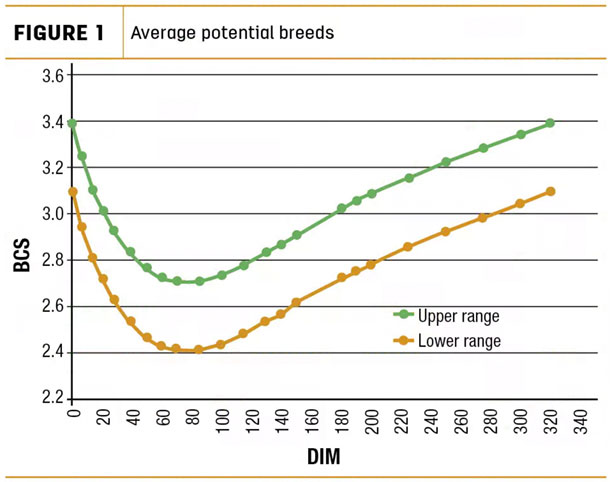
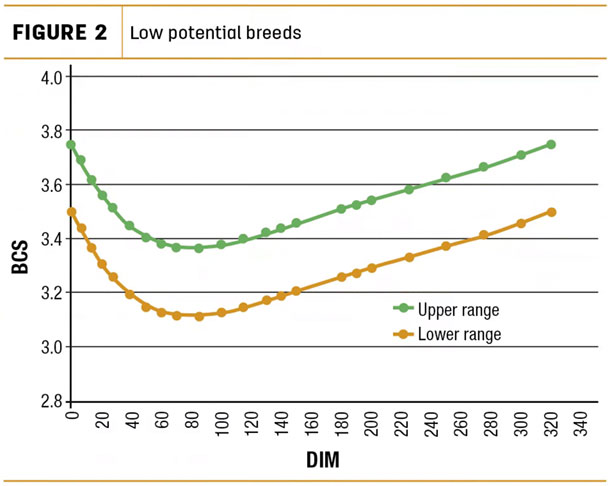
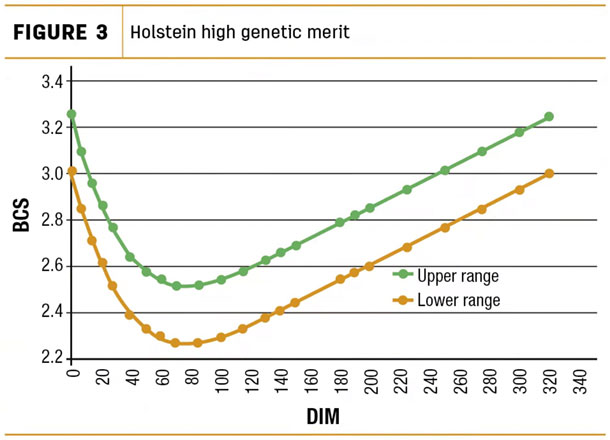
BCS projection model
Although routine BCS evaluation allows the making of “adjustments” for an optimal BCS at calving, an accurate prediction of it would allow better fine-tuning of diets according to objectives and predicted animal responses.
In 1999, the National Research Council (NRC) equations predicting nutrient requirements of beef cattle were modified to predict body composition for BCS in dairy cattle. The new equations were then included in the 7th revised edition of the “Nutrient Requirements of Dairy Cattle” (NRC, 2001) and implemented in the Cornell Net Carbohydrate and Protein System (CNCPS) and Nutritional Dynamic System (NDS).
This approach, however, does not consider nutrients partitioning as the physiological status of the animal changes during lactation. Soon after parturition, fat catabolism occurs, providing extra energy for milk production. As time progresses, a shift in priority occurs to replace body fat. The point of shift differs based on the animal’s production potential.
The production potential in the CNCPS refers to the expected peak milk yield for each specific breed. Therefore, it does not consider individual variability within a breed and does not accurately describe the actual cow’s potential. In the BCS prediction equations developed by our team, the fat catabolism equation, adjusted according to the actual cow’s potential, was thus implemented.
The “cow’s actual potential” is calculated as predicted peak milk yield over breed-specific peak. According to these equations, the energy balance is partitioned between possible milk production response and mobilized/stored body reserves. Consequently, the software platform generates BCS projections expected in short, medium and long terms (30, 60, 90 days and at dry-off).
Validation of the projection model
The proposed BCS projection model (BCSNDS) was validated using data from 63 pluriparous Jersey cows. Lactation number, parity, age, bodyweight, BCS, milk yield and composition at five days in milk (DIM) were included in both the BCSNDS and the CNCPS model. The observed BCS taken at 35 DIM was used to validate the models. The parameters predicted by the CNCPS and BCSNDS models were regressed on the observed ones. The CNCPS model had R2 lower than 0.50, with BCSNDS having R2 of 0.66. (Figure 4).
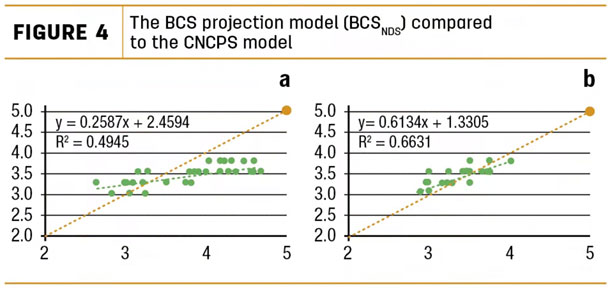
From a preliminary observation, the BCSNDS model seems to better predict BCS at 35 DIM for both high-producing and medium- to low-producing cows compared to the CNCPS model.
The function
In the “Animal Inputs” section of the software program, selecting the breed and typing in the milk production, the model will show in the chart section the best-fitting BCS ideal profile. By completing the animal inputs section and by inserting the diet, the BCS projections proposed by the BCSNDS model will be reported (Figures 5 and 6).
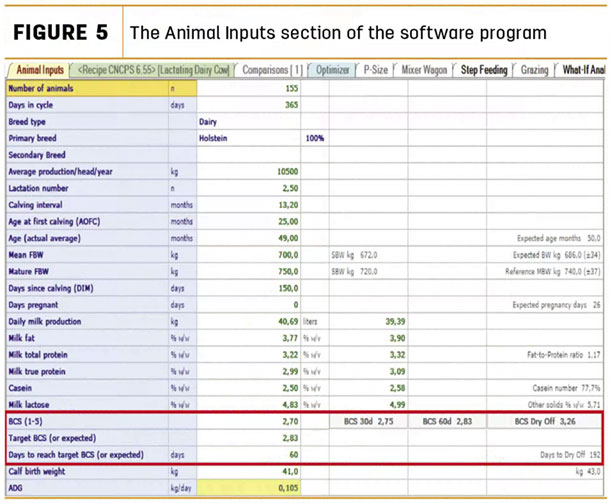
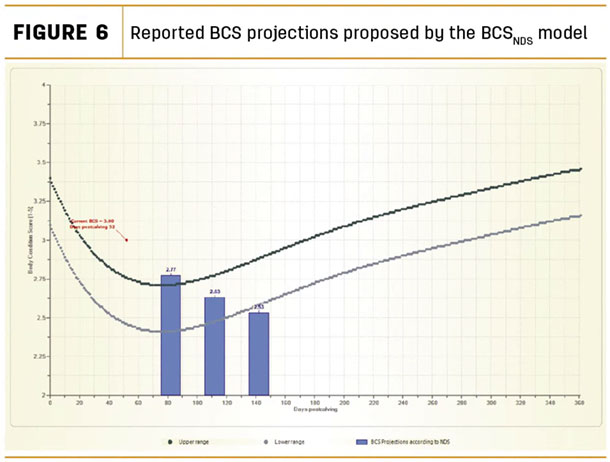
Entering in the “Target BCS” (or expected) field the value proposed by the BCS projections and in the “Days to reach target BCS” the days corresponding to the BCS selected (e.g., 30 or 60 days), the program recalculates the available energy balance, taking into account the energy partitioning with BCS changes.
Conclusions and implications
The model proposed better predicts fat catabolism and therefore BCS, especially when working with medium- to low-producing dairy cows, thus providing users with more accurate decision-making tools. However, it is important to highlight the accuracy of the BCS projection decreases for long-term projections because the model does not take into account possible changes of diet and variation in milk production later in lactation. Research in this field will continue to improve long-term accuracy prediction.






